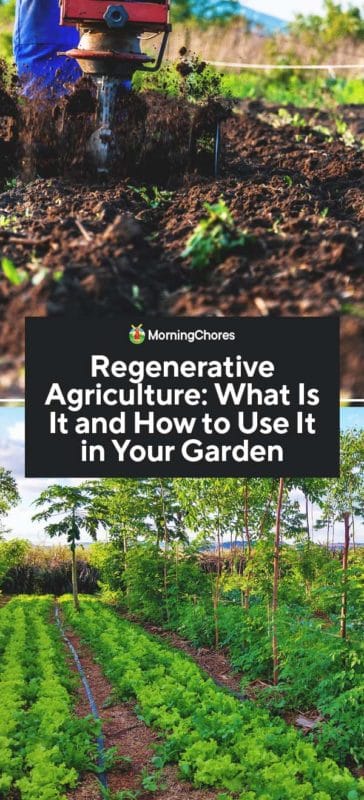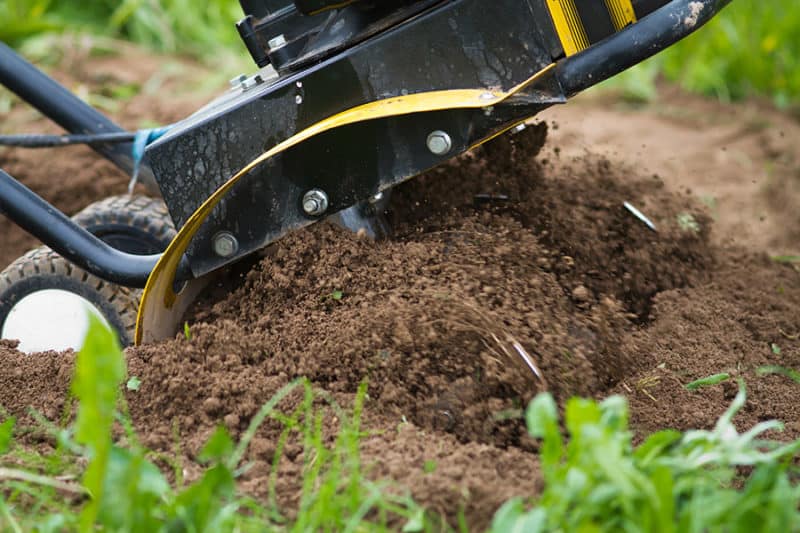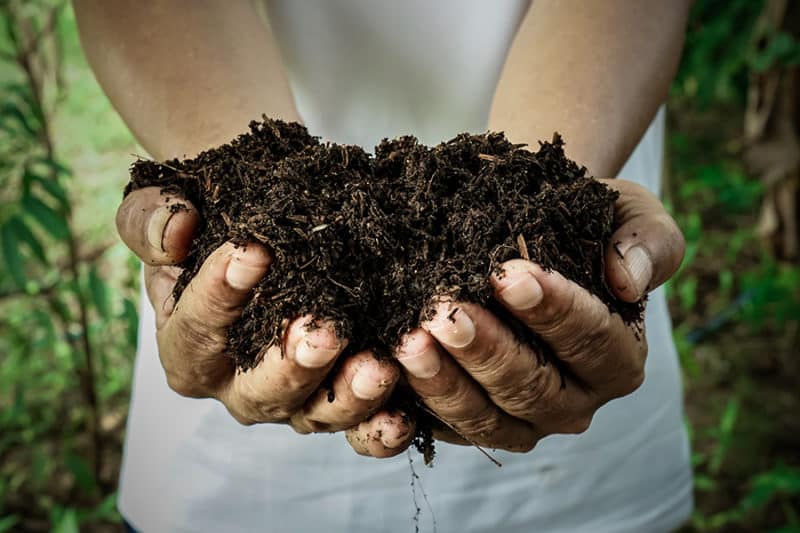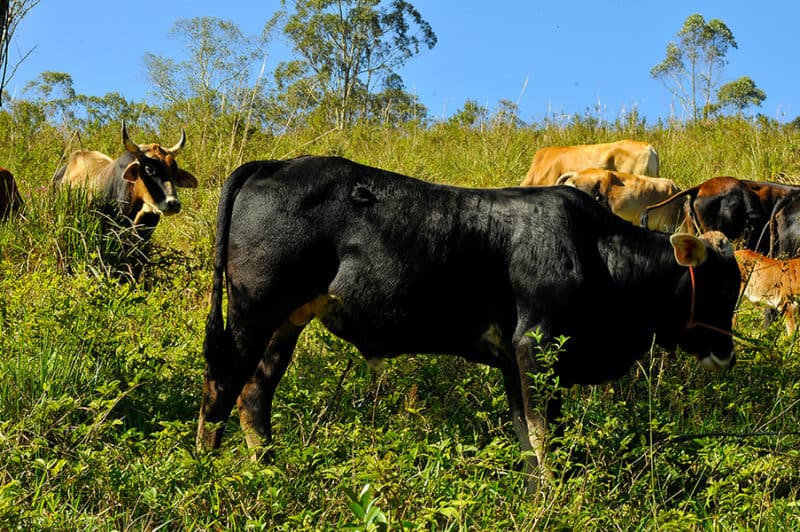What happens when you mix together permaculture, organic farming, wildlife conservation, and forestry? It’s called regenerative agriculture, and it’s a technique that you can use to can improve the environment on your farm – and the planet.
I’ve been farming sustainably for a long time, but I still viewed my farm in sections, with some areas dedicated to producing food, some for supporting animals, and others where I allowed wildlife to grow.
Since I started implementing regenerative techniques, I view my farm more holistically, and everything has benefitted as a result. Here’s how you can use these techniques in your garden.

What Is Regenerative Agriculture?
Regenerative agriculture encourages you to take a holistic view of the land. It starts with building good soil, which means improving the ground’s water retention, its ability to sequester carbon and adding to the diversity of microorganisms.
It also takes into account the way you utilize the carbon in your soil, the way you manage your livestock, and incorporates forestry into your garden spaces to reduce emissions on the farm.
That’s just scratching the surface, though. Encouraging diversity through regenerative agriculture has a wide-reaching impact. Good soil and water management benefits the native plants and animals in the area, which improves the environment on your land in return.
Regenerative farmers take to heart the expression “do no harm” when referring to the land, and then they take it one step further. The intent is to have an overall positive impact on the ecological community.
By increasing biodiversity, enriching the soils, and improving watersheds, the whole ecosystem improves.
Let Nature do the Work
Regenerative agriculture allows nature to do the work. You may worry this means weeds everywhere and trees overtaking your pastures. Nope. Remember this is about management.
Instead of letting things go wild, you’ll be creating systems that work hand-in-hand with nature.
For instance, by creating good soil with 2-10% organic matter, we allow for natural processes to take place. Organic matter improves the soil because it helps to hold moisture, and protects against nutrient runoff and erosion. It also creates a healthy soil microbiome that encourages plant growth.
By allowing certain plants to grow among your crops, you encourage birds to visit, who will eat the insects that can destroy your plants. That’s less work and fewer chemicals you have to use to keep your garden happy – all by harnessing nature.
5 Regenerative Practices to Start Right Away
What do farmers who want to farm regeneratively do differently? While they incorporate many of the things that organic gardeners and farmers do, they take things a step further. This involves taking into account the broader view that we are all part of an ecological community.
In other words, what benefits the environment has a positive impact on all of us.
I’ve begun incorporating my woods and waterways, along with my livestock into my overall farm plan. Not only do I feel better about my impact on the planet, but my homestead is healthier as a result.
Below are some of the practices that are the foundation of the regenerative agriculture movement.
No-Tilling or Minimal-Tilling
No-till or minimal-till practices protect the microorganisms and bacteria that live in the soil. Tilling disrupts the life cycles of many beneficial organisms.

Healthy soil contains millions of soil organisms. In fact, according to the USDA, there are more soil microorganisms in one small teaspoon of healthy soil than the number of people on the earth!
When testing soil for nutrients and organic matter soil scientists found the highest levels in fence rows. Why? That’s where there was the lowest amount of soil disturbance. Limiting soil disruption has benefits.
That’s not to say that there is never a time or place for tilling, but rather than doing it as a default, regenerative agriculture requires that you use careful consideration before disturbing the soil.
Plant Cover Crops
Cover crops help by keeping the soil planted at all times – not just when you are growing food crops. When the soil is covered, it absorbs moisture and prevents erosion. Erosion is the enemy of soil building because it leaches nutrients. The constant cover also helps protect the microorganisms that live in the soil.
Cover crops aren’t a new idea. Over 200 years ago, Thomas Jefferson wrote about his use of cover crops like vetch, turnips, and peas in his tobacco fields.
Cover crops are also a great way to feed your livestock. While you’re at it, be sure to rotate your crops frequently as well.
Use Lots of Compost

Compost is an important part of the cycle of life in the garden. You can use various composts in your garden, including compost teas and inoculations, as well as animal manures.
Plant Borders and Fringe Areas
Planting your borders (or just allowing “weeds” to grow) can improve habitat for bees and other beneficial insects.
It’s not always wise to allow weeds to grow since some can transfer disease, so consider what weeds are sprouting up before deciding to let them flourish.
Push-Pull System
Push-pull is a strategy to manage pests. The push refers to plants that repel pests. Some plants emit odors, oils or toxins that make them unpleasant to certain insects and animals. We often talk about them in companion planting.
The pull refers to plants that act as trap crops for pests. For example, corn is often attacked by stem borers. Several grass species of plants such as sudangrass, attract stem borers and keep them from bothering the corn crop.
Planting push-pull species helps you improve yields and reduce losses due to insect damage. It also benefits you economically because the cost is low and it reduces or eliminates the need for pesticides.
Multiple crops can be used in an intercrop planting. A biodiverse planting of several species is more naturally resistant to diseases than one single crop. In addition, when you intercrop, the plants are closer together. That density out-competes the weeds.
The three sisters’ garden is a great example of this technique in action. Corn, beans, and squash are planted together in a way where each plant is helping the others.
How to Incorporate Agroforestry
Agroforestry is a combination of forestry and agriculture with the goal of sustainability. It’s based on five practices which include; using windbreaks, riparian forest buffers, alley cropping, silvopasture and growing food in the forest.
Windbreaks and Riparian Buffers
Both of these work to protect certain areas of your property. A windbreak made up of evergreens may protect your garden or your home. Riparian buffers often protect waterways and provide habitat for native species.
Alley Cropping
Alley cropping utilizes rows of trees between planting areas. Often farmers plant Christmas trees or other trees with a market value. Some farmers just want to have the biomass and carbon sink.
Either way, the trees can help protect crops, encourage wildlife and beneficial insects, and create microclimates than can improve your yields.
Silvopasture
Silvopasture is when you integrate trees, forage crops, brush and grasses into your fields. Then, by using managed grazing practices, you provide food and shelter for wildlife and livestock while increasing biodiversity.
Trees and bushes provide shelter for livestock during inclement or hot weather. They also provide shelter for songbirds which often eat harmful insect pests. Other animals, such as opossums, are great at reducing diseases by eating ticks.
In addition, nut and fruit trees may provide food for livestock and humans. This can also bring in additional farm income and can improve the health of your animals by diversifying their diet.
Forests For Food Production
Many of us look for a nice sunny level spot in which to put the family garden. This is important for many vegetables. However, there are many crops that you can grow in the woods.
Forest farming is gaining in popularity. Herbs such as ginseng, goldenseal, and black cohosh are in high demand and command a high price. Other in-demand shade crops are shitake mushrooms, elderberry, and currents.
Livestock Practices to Encourage Regenerative Agriculture
Many people are concerned about the ethics of keeping livestock, a response to some commercial farming practices that are inhumane. However, regenerative agriculture seeks to allow livestock to live naturally and perform an important function on the farm.

In a good management system, livestock is rotated through the fields. As they graze, the livestock eats plants and brush, which serves several vital functions.
First, when there are plenty of plant options for them, livestock will choose some plants over others. The plants they don’t choose may be trampled or laid down upon. This is helpful to the field ecosystem as it pushes seeds into the soil.
The hooves and claws of your animals will break up the soil and compact inedible plants. This allows nutrients and sunlight to reach more favorable plants. Essentially your livestock is helping to build soil organic matter.
Chickens will eat nasty bugs and kick up the soil to help aerate it. This can also destroy weeds.
The key is continually rotating your animals so that they don’t begin to damage your plants and choosing the right time to let your animals roam through an area.
Incorporate Carbon Farming to Fight Climate Change
The temperatures on the earth are changing and scientists have linked these changes to the use of fossil fuels. One of the negative climates affects is caused by the disruption of the natural carbon balance. We now have an abundance of carbon in the atmosphere.
Carbon farming happens when growers intentionally encourage the soil to absorb carbon from the air. The soil can absorb carbon and small amounts of carbon are good for plants.
Carbon absorption is often a result of no-till practices and building soil up to healthy nutrient-rich levels. This is a natural process but is often disrupted by commercial farming practices.
Organic farming practices such as composting, rotating livestock, and cover cropping all help to sequester carbon in the soil. In fact, regenerative farming can balance out the methane produced by cattle.
Will Harris, who owns a large cattle farm in Georgia, reports that his farm provides a carbon sink that offsets the emissions produced by his beef production.
Advantages of Regenerative Agriculture
- Increased farmland utilization
- Using your land more efficiently
- Diversifies farm income and increases farm viability
- Creates biodiverse habitats
- Builds soil fertility
- Higher yields
- Improves water quality
- Increases crop resistance
- Greater nutrient density in plants
- Increases wildlife diversity
- Helps reduce negative effects of climate change
Disadvantages of Regenerative Agriculture
While I am pretty excited about regenerative agriculture, there are some drawbacks.
- It takes time. Trees do not grow overnight and soil needs time to improve.
- It takes planning and organization. A long term plan is a must.
- The set up can be labor-intensive.
Put Regenerative Agriculture to Work for You
We have a responsibility to leave the land in better shape than it was in when we received it. Regenerative agriculture does just that, giving us the opportunity to have a sustainable farm that provides for us while making improvements to the environment.
You don’t have to completely alter your homestead to incorporate these techniques, either. Simply add a few here and there over time and you’ll be surprised at what a difference a few changes can make.
